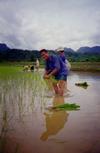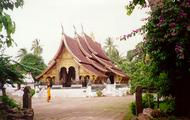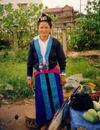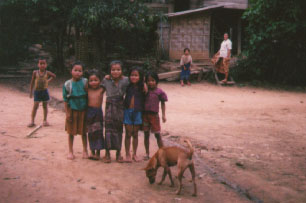
I hired an old motorcycle driver to bring me from Dong Ha, Vietnam, to Lao Bao, at the border of Lao. The border crossing was full of girls asking to trade Lao kip for U.S. Dollars. It was about 3000 kip to the dollar, which meant that the kip had fallen 60% since the last time I had checked rates, which was just a month earlier. After getting through customs, I walked into Lao. The border town was full of dusty wooden buildings centered around a market. At the bus station, I discovered that no bus was leaving for Savannakhet that day, but I was pretty anxious to get moving. It was late morning and I really didn't want to spend a whole day in this little border village. The only bus leaving that day went to Phim, which was halfway to Savannakhet. I took it.
Buses in Lao are slow. You almost need to meditate as you go or you'll go nuts. Every time I took the bus to another town, another day was lost. Even a 100km trip would take eight or so hours. I really don't know where the time goes. I think we averaged about 15km/hr. We would stop fairly frequently. Often it was a bathroom break, where everyone would go about twenty feet from the bus, do his or her business, then return. Sometimes, it was to stop and buy vegetables from the roadside sellers. Sometimes, it was just a single woman selling a couple of squashes, and our bus stop and release a dozen the women rushing out to buy them. I ate a lot of boiled starchy corn-on-the-cob from these stands.
I was dropped off at the main intersection in Phim. It was really the only intersection, and the buildings were set back quite far. I walked to the giant Stalin-era concrete hotel monstrosity and found it completely deserted. I walked to a nearby house to find the caretaker, who led me to a random second-floor room then gave me a key and a candle. The room was $1 a night. I set up the holey mosquito net above the bed, and went to the bathroom. It was a typical Southeast Asian one, with a squat toilet in the corner. The unexpected item was the four-foot tall ceramic jug that contained water. I have no idea how the water was brought up there or how long it had been sitting. I used the little plastic scoop to flush the toilet.
After dropping off my stuff, I wandered down the road in search of dinner. I found a couple of little stands that sold horrible little skewers of meat, noodles, and this noodles-in-milky fluid dessert. As I sat down with my noodles, I was approached by a young Lao man who asked, "Do you drink alcohol?" Hmm. I explained that thank you, no, my stomach was a little sick and I shouldn't drink. He walked off, chatted with his friends who were sitting on a wooden platform by the stalls, then returned to invited me to sit with them. They were passing around a little glass soda bottle full of lao lao, or rice whiskey. When it came to me, I took a drink. The men I was drinking with were either working for UXOLAO (the UneXploded Ordinance people) or the forest service.
I later learned that I was pretty close to a major site on the Ho Chi Minh trail. The US saturation-bombed the border of Vietnam and Lao. I was also told that the planes were not allowed to return with bombs, so rather than drop them in the ocean, they were frequently dumped on Lao. In some areas, like Phongsali, there were more bomb casings than wood, so people made houses out of them. UXOLAO appeared to be one of the major employers of Lao men. Sometimes, it is just plain embarrassing to be an American. Another thing I discovered is that it was the French who added the "s" to Lao, and that the locals all called their country Lao. Many of the backpackers did too.
The next day, I waited by the roadside until the bus to Savannakhet came. I got to Savannakhet hours later. It is a peaceful town on the Mekong with a few guest houses and restaurants for tourists. I decided to follow the Lonely Planet's advice and try the laap at a particular restaurant. I was presented with a big plate of extremely spicy bits of meat and various horrible leaves to eat them with. I also got a large bowl of gristly soup. One generally does not come to Lao for the food.
Savannakhet is known for its Buddhist monasteries. I visited one along the river and talked a bit with a young novice. It was the time of year for the young men of Laos to do their service at the monasteries. Originally, the men were supposed to serve for a year, but now I think only a couple of weeks were required. This means that there were lots of young Lao guys with shaven heads and saffron robes, but who were otherwise just normal teenagers. They could be found with their boomboxes and cigarettes.
I travelled to the capital of Vientiane the next day. I chatted with a couple of university students from Savannakhet who were headed back to the capital to take exams. They were studying to be engineers. I wondered what an engineer could do in a country with so little capital, but I didn't ask.
I thought Vientiane was pretty miserable. There were two paved roads, and the rest were mud. Often ankle-deep mud. The numerous puddles were a fantastic mosquito breeding ground. Tevas were incredibly useful. There was a lot of digging and construction to get the city ready for next year's "Visit Laos" campaign. I think that every year, some country in Southeast Asia is chosen to be the target of a big tourism campaign. In Thailand, I saw banners from the previous year's "Thailand Beautiful".
Vientiane has a large market. In fact, there were lots of tourists who were taking a day out of their Thailand vacations to stop by Laos for a day. It's a shame that they were visiting one of the less-pleasant cities in Laos, but at least it is easy to reach from the Thai side. I bought a weird camera in the market, as my old one was damaged in a monsoon in Phnom Penh. Now I could start taking pictures again.
My next stop was Vang Vieng, which was a nice way to break up the trip to Luang Prabang. This is where the buses turned into pickup trucks with bars and planks in the bed for passengers. I think they managed to get 20 people on these things. Vang Vieng was set among limestone caves and farmland. There were lots of backpackers, making accommodations easy to find. I stayed in what was essentially a plywood locker.
Many of the caves had Buddhist shrines in their entrances. We were somewhat surprised to meet a saffron-robed monk at the mouth of one of the larger caves. As we walked further into the cave together, he explained that monks would travel to find a place to meditate before the rainy season so they would not need to move during the monsoons. The caves went on for kilometers, but a chain-link fence blocked our way after a couple of hundred feet. The monk bid us farewell then ducked under the fence and disappeared into the darkness.
 After a couple of days in Vang Vieng, I headed for Luang
Prabang. This was really a wonderful city. It was full of
old Buddhist temples and colonial architecture. It is one
of those unspoiled places that a backpacker longs for then
spoils in a couple of years. After I got back to the States,
I saw articles about Luang Prabang being the obscure "cool"
place to visit. Luang Prabang may also have the only good
restaurants in Laos. Unfortunately, I didn't try many of
them because I ate with the family who owned the guesthouse
I was staying in. It's really a hard choice - eat fine
Lao cuisine or eat with a Lao family. And given how nice
everyone I met in Laos was, I couldn't turn the family down.
We often ate spicy chili bamboo shoots, sticky rice, and
a sort of chicken stew. Lao sticky rice is unique -
you pick up a bunch with your fingers, roll it into a ball,
then dip the ball into soup and eat it. The rice was slightly
tacky to the touch. In a country without running water, toilet
paper, or soap, you can understand why I was slightly averse
to eating with my hands and out of communal stews. I pretty
much continuously had the runs.
After a couple of days in Vang Vieng, I headed for Luang
Prabang. This was really a wonderful city. It was full of
old Buddhist temples and colonial architecture. It is one
of those unspoiled places that a backpacker longs for then
spoils in a couple of years. After I got back to the States,
I saw articles about Luang Prabang being the obscure "cool"
place to visit. Luang Prabang may also have the only good
restaurants in Laos. Unfortunately, I didn't try many of
them because I ate with the family who owned the guesthouse
I was staying in. It's really a hard choice - eat fine
Lao cuisine or eat with a Lao family. And given how nice
everyone I met in Laos was, I couldn't turn the family down.
We often ate spicy chili bamboo shoots, sticky rice, and
a sort of chicken stew. Lao sticky rice is unique -
you pick up a bunch with your fingers, roll it into a ball,
then dip the ball into soup and eat it. The rice was slightly
tacky to the touch. In a country without running water, toilet
paper, or soap, you can understand why I was slightly averse
to eating with my hands and out of communal stews. I pretty
much continuously had the runs.
 A couple of days later, I left my backpacker friends in
Luang Prabang and went north to Muang Xai. My goal was
to reach Muang Sing, which was just a little further north,
in a couple of days. Muang Xai is one of the northern Lao
towns that received construction help from the Chinese, as
evidenced by the optimistically wide paved central road.
It has a large central market and appears to be a transport
hub for northwestern Lao. Along the road to the market,
there were many Hmong woman vegetable-sellers who were averse
to begin photographed. I bought a pineapple from this
Blue Hmong woman in exchange for taking a photo.
The pineapple was delicious
and cost about 600 kip. At these prices, it is really tempting
to eat entire pineapples all the time until you get sick.
I met a fair number of tourists with acidy stomachs from
doing this.
The bananas were pretty good, too, but they were usually
sold in tree-sized bundles.
A couple of days later, I left my backpacker friends in
Luang Prabang and went north to Muang Xai. My goal was
to reach Muang Sing, which was just a little further north,
in a couple of days. Muang Xai is one of the northern Lao
towns that received construction help from the Chinese, as
evidenced by the optimistically wide paved central road.
It has a large central market and appears to be a transport
hub for northwestern Lao. Along the road to the market,
there were many Hmong woman vegetable-sellers who were averse
to begin photographed. I bought a pineapple from this
Blue Hmong woman in exchange for taking a photo.
The pineapple was delicious
and cost about 600 kip. At these prices, it is really tempting
to eat entire pineapples all the time until you get sick.
I met a fair number of tourists with acidy stomachs from
doing this.
The bananas were pretty good, too, but they were usually
sold in tree-sized bundles.
A day later, I went to Muang Sing, which features one of the largest hill tribe markets around. There must have been at least five distinct tribes at the market when I was there. The hill tribe people often wear their traditional clothes. Some were beautifully embroidered. There was one group of young men who were wearing black shirts and what looked like green drivers hats, giving the Lao brat pack look. I wondered if this was the mass-produced version of what they would have worn in the past.
The hill tribes make this little town a magnet for photographers. Many of them were insensitive tourists who would take closeups of the locals and walk away without giving them anything. I found this so distasteful, that I didn't take pictures here. But I talked to a few professionals who spent weeks there befriending the locals. One of the photographers brought a Yao (or Mien) family a large print of a photo he had taken of them the year before. The mother looked pained, and he discovered that the baby had recently died of eating a bottle of malaria medication when the family wasn't looking. The mother blamed herself and was wasting away.
Muang Sing is only a few kilometers from the Chinese border. I rented an awful bike and visited the nearby Yao and Akha villages, then continued on towards the border. I got to the Lao border crossing, and couldn't find anyone around. So I just kept on going. After huffing a couple of kilometers into this border area, I encountered giant construction equipment and little wooden houses of their operators. I asked one of the workers (in Chinese) if I was in China yet, and he told me that I was. Feeling a bit panicky about being stuck between the borders of Laos and China without a Chinese visa, I sped back to Laos, where I nonchalantly biked past the guards.
I can't help ascribing personalities to the Yao and Akha tribes. Only the older women were in the villages when I visited in the middle of the day. The Yao looked like the peak of gentleness with their huge turban-like headdresses, enormous foofie red collars, and intricate embroidery. The old Akha women kind of scared me. They were topless, wearing only a hand-woven cloth around their hips and a headdress studded with bits of metal and old coins. When I encountered them, they often held out their hands for money and red betelnut juice dripped from their mouths. One of the American photographers said that the Akha seemed like masochists. They would strap a yoke-like device to their heads to drag a fifty-pound bag of grain from the market to their village several miles away. I do suspect that I just happened to encounter the grouchiest Akha women, and the same photographer pointed out a mild-looking Akha man and his cute little girl to me in the market. I also think that they were the most primitive and exotic-looking people in the town, so the tourists have probably been annoying them for years.
I was starting to feel pretty self-conscious about gawking at the hill-tribes, so I decided it was time to return to Thailand. I went to the town of Luang Nam Tha, and discovered that the road to Chiang Khong, Thailand, was washed out. The only way to get to Thailand was to double back to Muang Xai, then go southwest from there. This would take at least three days. The other options were either 1) to buy an elephant, which would not get stuck on the road to Chiang Khong, or 2) take a boat on the Nam Tha river. I had heard that when a vehicle gets stuck in the mud in Laos, it could take a couple of days to summon a larger vehicle to pull it out. And when the largest vehicles, the six-wheeled military transports, gets stuck, it's time to get the elephants. It was not obvious to me how to acquire an elephant, so I opted for the boat. A tourist had told me that the river was shallow and barely navigable at this time, and that tourists have died taking it. After a little more discussion, I figured that the river was the proper way to go.
I got to the boat launch in Luang Nam Tha and the boat owner said that he would take off after we got three more tourists to pay the fare. After a few hours, it was obvious that no one else was coming. He told me that he could take me if I was willing to pay all the fares - 300,000 kip, or about $100, a truly phenomenal sum in Laos. I had earlier been told that petrol was expensive and the trip from Luang Nam Tha to Thailand was long and upstream. I explained to the man that this was too much, even for an American, and he agreed to take me for 70,000 kip. My expenses in Laos were far lower than I had expected, so I was happy to spend the rest of my kip. The largest note in common circulation was 1000 kip, so when you change $50, as I did back in Luang Prabang, you end up getting 150 bills. Unless your money changer has 500 kip notes, then you get 300 bills. The unfortunate tourists who changed $200 stuffed inch-high stacks of kip into their bulging once-concealed moneybelts, then put the rest into bags. Needless to say, pickpocketing is just silly when you need to steal a wheelbarrow full of bills to be rich.
 We took on three Lao passengers in a village just downriver.
The river was essentially rapids for a good part of the
first day. We zig-zagged across the river to avoid rocks,
and I hoped that the plastic bags in my backpack would keep
everything dry and that my baseball cap would keep my head from
being split on the rocks.
We stopped in the tiny town of Malee for the night. It was a tiny
village only accessible by boat at this time of year.
The little kids asked me for bubble gum or balloons, which I
did not have, then they posed for a picture before running away
giggling. I spent a lot of the evening showing the children
the color photos from my guidebooks.
We took on three Lao passengers in a village just downriver.
The river was essentially rapids for a good part of the
first day. We zig-zagged across the river to avoid rocks,
and I hoped that the plastic bags in my backpack would keep
everything dry and that my baseball cap would keep my head from
being split on the rocks.
We stopped in the tiny town of Malee for the night. It was a tiny
village only accessible by boat at this time of year.
The little kids asked me for bubble gum or balloons, which I
did not have, then they posed for a picture before running away
giggling. I spent a lot of the evening showing the children
the color photos from my guidebooks.
The next day, we arrived at the mouth of the Nam Tha, which empties on the Mekong River, which forms part of the border with Thailand. I took a ride on a shockingly modern speedboat to get to the Thai side of the the river. I was issued a crash helmet and the boat must have been going 80 miles an hour. When I got to the Thai side, I swapped my kip for Thai baht with a backpacker heading in the other direction then watched the last rays of the setting sun hit the Mekong.